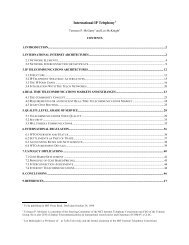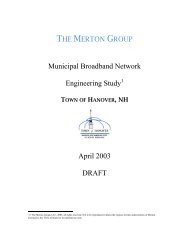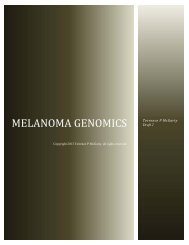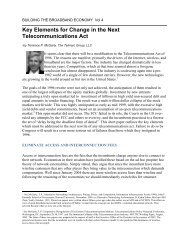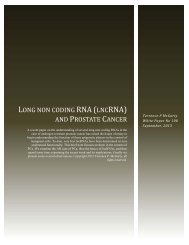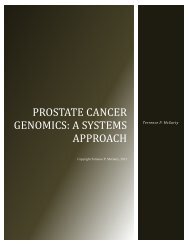progressivism, individualism, and the public ... - Telmarc Group
progressivism, individualism, and the public ... - Telmarc Group
progressivism, individualism, and the public ... - Telmarc Group
Create successful ePaper yourself
Turn your PDF publications into a flip-book with our unique Google optimized e-Paper software.
The <strong>Telmarc</strong> <strong>Group</strong><br />
PROGRESSIVISM, INDIVIDUALISM, AND THE PUBLIC<br />
INTELLECTUAL<br />
In Hofstadter’s case this meant exploring in a systematic way “<strong>the</strong> sociological<br />
penumbra of political life” — <strong>the</strong> murky substratum of desires <strong>and</strong> impulses that<br />
underlay <strong>the</strong> surface pageantry of American politics. He was much impressed by “The<br />
Authoritarian Personality” (1950), a survey of contemporary American political attitudes<br />
compiled by a team of researchers under <strong>the</strong> direction of <strong>the</strong> German émigré Theodore<br />
Adorno. Hofstadter adapted Adorno’s “social-psychological categories” in his essay<br />
“The Pseudo-Conservative Revolt,” an attempt to uncover <strong>the</strong> hidden sources of<br />
McCarthyism. "<br />
Tanenhaus continues:<br />
"In <strong>the</strong> boom years of <strong>the</strong> 1920’s, for instance, millions of small-town <strong>and</strong> rural “native<br />
stock” Americans, alarmed by <strong>the</strong> ascendancy of <strong>the</strong> country’s pluralistic urban culture,<br />
had embraced <strong>the</strong> organized bigotry of <strong>the</strong> Ku Klux Klan <strong>and</strong> flocked to <strong>the</strong> punitive<br />
crusades of anti-evolutionism <strong>and</strong> Prohibition. The pattern was being repeated in <strong>the</strong><br />
1950’s, also a boom period, only now it was a curious alliance of upwardly mobile white<br />
ethnics (many of <strong>the</strong>m Catholics) <strong>and</strong> downwardly sinking displaced WASPs, who looked<br />
to secure <strong>the</strong>ir status as au<strong>the</strong>ntic Americans by converging upon “liberals, critics <strong>and</strong><br />
nonconformists of various sorts, as well as Communists <strong>and</strong> suspected Communists.….<br />
And if, as Hofstadter maintained, political issues now reflected a wider cultural debate<br />
over “<strong>the</strong> capacity of various groups <strong>and</strong> occupations to comm<strong>and</strong> personal deference in<br />
society,” <strong>the</strong>n <strong>the</strong> largely Jewish inhabitants of what Brown calls <strong>the</strong> “Claremont Avenue<br />
ghetto” were, for all <strong>the</strong>ir seeming detachment, as deeply embroiled in <strong>the</strong> struggle as<br />
Midwestern rubes or urban Catholics."<br />
The characterization of Midwestern rubes <strong>and</strong> urban Catholics <strong>and</strong> <strong>the</strong>ir anti<strong>the</strong>sis which<br />
he calls <strong>the</strong> Claremont Avenue Jews 153 are somehow in a massive cultural struggle, with<br />
<strong>the</strong>se bone headed rubes <strong>and</strong> Papists pitted against <strong>the</strong> small enclave of intellectuals who<br />
have singular knowledge of <strong>the</strong> truth.<br />
The small group of left wing intellectuals, according to Hofstadter, has taken <strong>the</strong> place of<br />
blacks, evolutionists <strong>and</strong> anti-prohibitionists, <strong>and</strong> <strong>the</strong> rubes <strong>and</strong> Papists are unjustly <strong>and</strong> in<br />
total ignorance attacking <strong>the</strong>m as a result of <strong>the</strong>ir deckling social status! The irony is that<br />
<strong>the</strong> Irish Catholics <strong>and</strong> Italian Catholics in New York at that time were still Police <strong>and</strong><br />
Garbage Collectors <strong>and</strong> had just returned from <strong>the</strong> War. Nei<strong>the</strong>r Hofstadter nor Bell had<br />
done <strong>the</strong> country <strong>the</strong> honor of such service <strong>and</strong> kept <strong>the</strong>ir comforts on <strong>the</strong> hill at<br />
Morningside Heights while <strong>the</strong> Irish Catholics, Italian Catholics <strong>and</strong> Protestant rubes<br />
from <strong>the</strong> mid West lost <strong>the</strong>ir lives defending <strong>the</strong>ir rights to call <strong>the</strong>m dolts! Yet <strong>the</strong>ir<br />
attitude was <strong>and</strong>, in many ways, remains pervasive at Columbia.<br />
153 Claremont Avenue is a small street that runs parallel to Riverside Drive on <strong>the</strong> West Side of Manhattan just west of<br />
Columbia University. It is a residential area for many Columbia faculty. In <strong>the</strong> 1950s <strong>and</strong> 1960s it was a mix of<br />
academic <strong>and</strong> middle class Jews. Many of <strong>the</strong> building were eventually taken over by Columbia.<br />
Page 144



